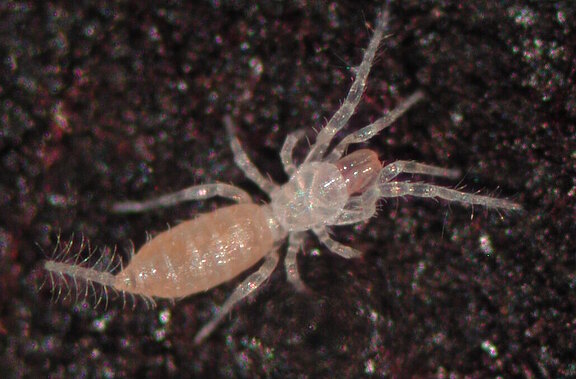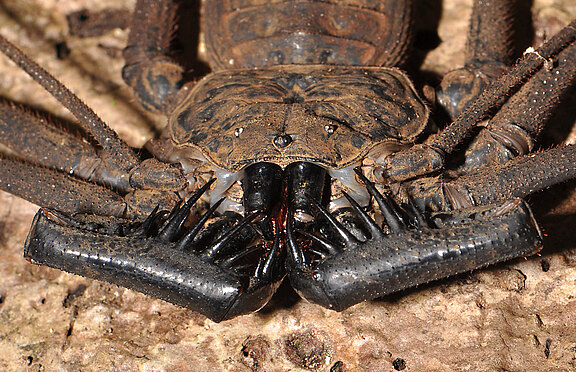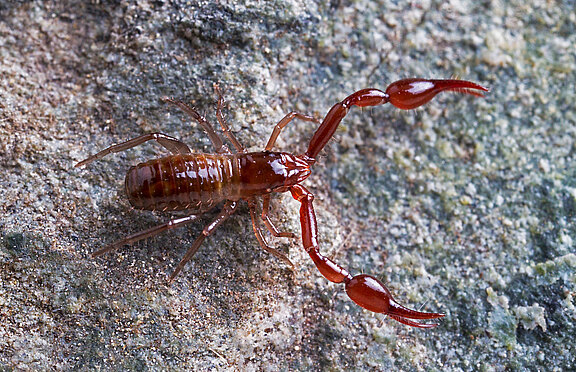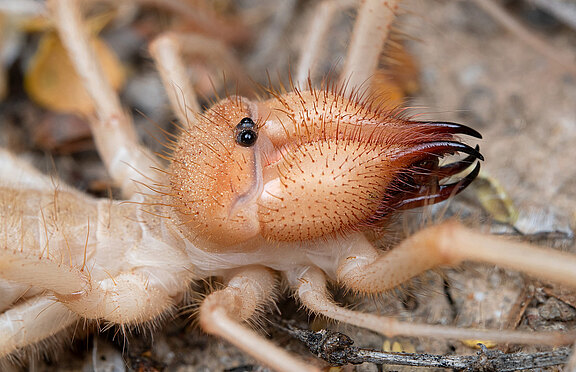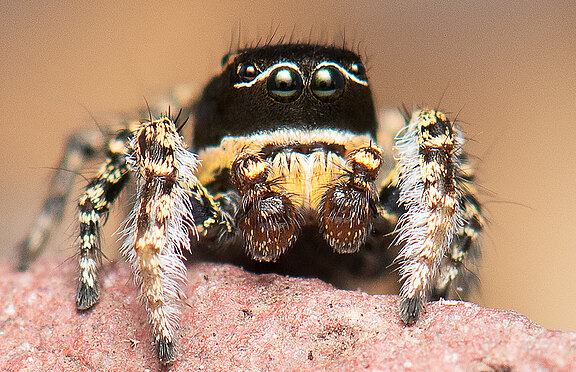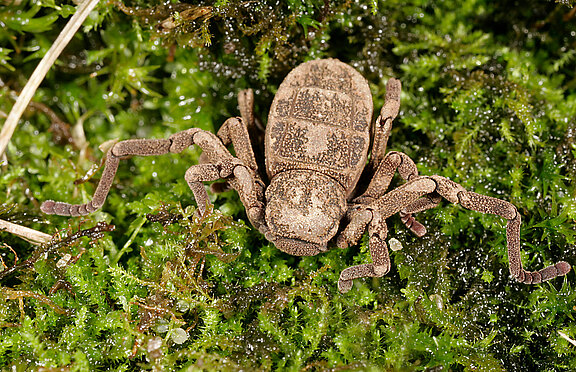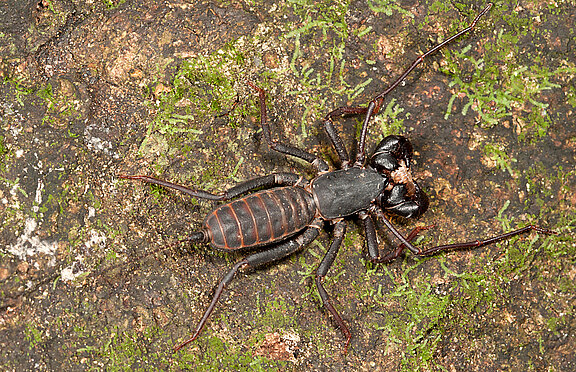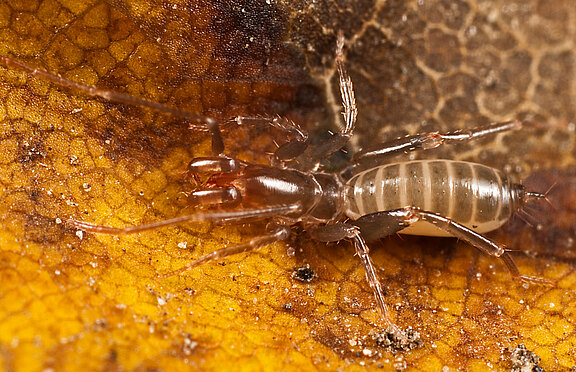List of all articles
Volume 51 Number 2
Whip-scorpion, biodiversity, new taxa
Abstract
The giant vinegaroons of the genus Mastigoproctus Pocock, 1894 have been the subject of recent investigations aimed at elucidating relationships between their species and their validity. In particular, new data have revealed the presence of new species as well as revalidated species that were previously considered as synonyms of Mastigoproctus giganteus (Lucas, 1835). The genus occurs in southern USA, Mexico and South America. In this paper, we describe three additional new species from Mexico: M. franckei Barrales-Alcalá, sp. nov. from Xilitla, San Luis Potosí, M. xetame Barrales-Alcalá & Francke, sp. nov. from the highlands of Jalisco and M. yalchanchak Barrales-Alcalá & Francke, sp. nov. from La Esperanza, Chiapas. The present contribution raises the diversity of the order Thelyphonida in Mexico to 10 species.
Los vinagrillos del género Mastigoproctus Pocock, 1894 han sido objeto de investigaciones recientes encaminadas a dilucidar las relaciones entre sus especies y la validez de las mismas. En particular, nuevos datos han revelado la presencia de nuevas especies, así como la validez de otras que antes se consideraban como sinónimos de Mastigoproctus giganteus (Lucas, 1835). El género se encuentra en el sur de Estados Unidos, México y Sudamérica. En este artículo, describimos tres nuevas especies adicionales de México: M. franckei Barrales-Alcalá, sp. nov. de Xilitla, San Luis Potosí, M. xetame Barrales-Alcalá & Francke, sp. nov. del altiplano de Jalisco y M. yalchanchak Barrales-Alcalá & Francke, sp. nov. de La Esperanza, Chiapas. La presente contribución eleva la diversidad del orden Thelyphonida en México a 10 especies.
Volume 51 Number 2
Mygalomorphae, East Asia, biogeographic hypothesis, dispersal, marine intertidal
Abstract
Most spiders are exclusively terrestrial with only some groups venturing into aquatic habitats, and only a handful of representatives colonizing the marine intertidal zone. Here, we describe a new intertidal trapdoor spider species, Idioctis parilarilao sp. nov., from southern Taiwan and Green Island (Lutao). The original DNA barcode enables species delimitation between different populations from Taiwan and the morphologically closest species, Idioctis xmas, from Christmas Island, Indian Ocean. These analyses reveal that all populations from Taiwan, including Green Island, are conspecific, and are distinct from Idioctis xmas. Given the lack of representation of other species in public databases, our COI gene tree should be seen as preliminary, but it does support the monophyly of the genus Idioctis. As the genus was not previously known from East Asia, our discovery vastly extends the distribution range of Idioctis and the family Barychelidae. Given the tectonic and volcanic specifics of the history of Taiwan and Green Island, and the direction of the known oceanic currents, we provide a preliminary explanation of the biogeographic and diversification history of intertidal spiders in the region.
Volume 51 Number 1
Aril, caloric value, diet, elaiosome, fruit waste, fungal spores, mushrooms, seeds.
Abstract
In this review, we report on harvestmen and spiders feeding on fungi, fruits, and seeds. Fungivory in harvestmen is widespread, with most reports referring to tropical species in the family Sclerosomatidae, which consume mainly small forest mushrooms (families Marasmiaceae and Mycenaceae). In contrast, consumption of fungal material by spiders apparently occurs only if airborne spores trapped in the viscid threads of orb-webs (e.g., Araneidae and Tetragnathidae) are ingested along with old webs prior to the construction of new webs. Consumption of fruit pulp by harvestmen is also widespread, with several records of Leiobunum spp. (Sclerosomatidae) feeding on Rubus spp. berries and other lipid-poor fruits in the Holarctic region. In Neotropical forests, harvestmen in the families Cosmetidae and Gonyleptidae feed on lipid-poor pulp of fallen fruits. Among spiders, we document several cases of synanthropic species opportunistically feeding on fruit waste (e.g., pieces of banana, papaya, watermelon, or orange pulp) inside houses or disposed in yards. Only one case of a spider feeding on a wild fruit in the field was found in our search. Finally, we report several cases of harvestmen and spiders feeding on elaiosomes or arils (i.e., lipid-rich seed appendages). In conclusion, harvestmen consume mushrooms, fruit pulp, seeds, and seed appendages more frequently than spiders probably because they are “solid food feeders”, which means they can ingest solid tissues by biting off small pieces. In turn, spiders are “fluid feeders” and feed on vegetable matter most frequently in the form of fluids (e.g., nectar, stigmatic exudate, plant sap, and honey dew), rather than fungal or plant tissues.
Volume 51 Number 1
Araneae abundance, richness, tree-shrub strata, composition, seasonal variation
Abstract
Spiders are usually found through all seasons in the subtropics, but little is known about their seasonality patterns and how they respond to abiotic factors, especially in species-rich regions such as Brazil. We investigated the seasonal variation in spider communities and the possible influence of abiotic factors (e.g., temperature, rainfall) on spider abundance, species richness and composition in subtropical riparian forest in four river basins. Changes in spider abundance among seasons differed between ontogenetic stages: there were more spiderlings in the autumn, and similar numbers of adults year round. Species richness, on the other hand, was highest in spring and summer. Species composition differed between seasons and river basins. Several factors may be behind diversity changes in the araneofauna among seasons, however, none of the abiotic factors evaluated showed a strong direct influence. Seasonal patterns varied, with different species having peaks in all three seasons but autumn. Seasonality is clear in these spider communities but not all patterns follow predictions from simple temperature changes.
Volume 51 Number 1
Abstract
A new species of giant trapdoor spider, Euoplos dignitas sp. nov. (family Idiopidae), is described from the Brigalow Belt of inland Queensland, Australia. Phylogenetic analysis of a six gene molecular dataset for the tribe Euoplini reveals that this species is sister to the spinnipes-group from eastern Queensland, and unrelated to a morphologically similar congener (E. grandis Wilson & Rix, 2019) that occurs further south in the Brigalow Belt. Both E. dignitas sp. nov. and E. grandis are very large, scopulate, plug door-building trapdoor spiders from transitional woodland habitats on vertosols (‘black soils’), with superficially similar females and strongly sexually-dimorphic ‘honey-red’ males. Information on the known biology and distribution of E. dignitas sp. nov. is summarized, and a conservation assessment is provided under the International Union for Conservation of Nature’s (IUCN) Red List Criteria, indicating that this species is likely Endangered.
Volume 51 Number 1
Harvestmen, Laniatores, Neotropics, Central America, rutrum, mons cribellatus.
Abstract
A new genus and species of Neotropical Grassatores, Hevelia crucis gen. et sp. nov., is described and illustrated based on material of both sexes from Colombia. After comparison with the greater groups in Zalmoxoidea, especially the putative early derivative families Guasiniidae and Icaleptidae, this new taxon is considered a Zalmoxoidea incertae sedis, and seems to be related with Trypophobica Cruz-López et al., 2021 (currently in Icaleptidae, but which should be removed from this family) and Costabrimma Goodnight & Goodnight, 1983 (currently in Zalmoxoidea incertae sedis), both from Central America. Two species currently included in the zalmoxid genus Stygnoleptes Banks, 1913 from El Salvador are transferred to Trypophobica, creating the new combinations T. gibbera (Roewer, 1954) and T. sellata (Roewer, 1954). Two morphological structures for Zalmoxoidea are named here: mons cribellatus (sexually dimorphic porous prosomal and/or abdominal dorsal hillock) and elbow-spade (lanceolate blade apical in the truncus penis).
Volume 51 Number 1
CTMin, CTMax Latrodectus, development, invasive species
Abstract
Temperature strongly shapes the physiology and distributions of ectotherms. Environmental extremes and the range of temperatures encountered can limit persistence. Further, thermal tolerance limits are thought to be one of the factors limiting the distributions of invasive species. The critical thermal maximum (CTMax) and critical thermal minimum (CTMin) are metrics frequently applied for defining upper and lower thermal tolerances, respectively. Temperatures contained within the boundaries of the CTMax and CTMin comprise the thermal tolerance range. In this study, we tested whether thermal tolerances differed between two native (Latrodectus hesperus Chamberlin & Ivie, 1935 and L. mactans (Fabricius, 1775)) and one invasive (L. geometricus CL Koch, 1841) widow species (Latrodectus Walckenaer, 1805). We separately tested if thermal tolerances differed by life stage and sex. Using species distribution modelling, we also tested if thermal extremes or temperature range most accurately correspond with current species occurrences in the United States. We hypothesized that Latrodectus geometricus would have lower thermal tolerance range and that minimum temperatures would most influence their present distributions since they presumably originated from a more equatorial climate. We found that CTMin did not vary by developmental stage, but was highest in males. We found that the CTMin and CTMax of L. geometricus (3.2, 51.5 °C) and L. mactans (1.9, 52.4 °C) were higher than L. hesperus (-1.9, 49.6 °C). Males also had the narrowest thermal tolerance range in the three species examined. Lastly, we found that the highest performing distribution model was the one correlating minimum temperature with L. geometricus occurrences.
Volume 51 Number 1
nest associates, commensals, web associates, Philoponella, social spiders
Abstract
Animals use nests for various functions including laying eggs, raising young and gaining protection from predators. Social insect colonies provide rich microhabitats for various foreign inhabitants. Social spiders in the family Eresidae live in large, long-lasting colonies with a dense silken nest where spiders reside in complex capture webs. Social spider colonies contain several organisms apart from the host spiders, yet little is known about the foreign species and their roles. In this study, we cataloged foreign animals found in the nests and webs of the Indian social spider Stegodyphus sarasinorum Karsch, 1892 from different sites in India. We then examined the abundance and diversity of foreign spiders in adult and juvenile colonies, and the nature of interaction of foreign spiders with host S. sarasinorum spiders. We found spiders classified into nine families and insects classified into five orders and a few small vertebrate taxa associated with S. sarasinorum colonies. Adult S. sarasinorum nests and webs contained significantly more foreign spiders than juvenile colonies. However, diversity of foreign spiders did not increase with the number of host spiders. Additionally, we found that foreign spiders found inside the nests preyed on individual S. sarasinorum spiders. Our study sheds light onto the intriguing biology of nest- and web-associates of social spiders.
Volume 51 Number 1
Lycosidae, courtship, copulation, sexual strategies, reproductive strategies.
Abstract
The family Lycosidae is one of the spider families with the greatest diversity of species and with varied and striking strategies. Studies on Neotropical wolf spiders have contributed new and valuable information to the field of sexual selection for several decades, having discovered cases that differ markedly from previously known patterns, not only for the family but for spiders in general. Here we provide a review of studies on reproductive biology of South American wolf spiders in recent decades, focusing on the subfamilies Lycosinae, Allocosinae and Sossipinae. The promising possibilities of the spiders of this family to test fundamental hypotheses in sexual selection and reproductive biology are highlighted, and we outline areas of particular interest for future studies. We hope that this review will inspire further studies on a broader range of wolf spider species in the Neotropics.
Volume 51 Number 1
Ogre-faced spider, web-building, sticky-silk spiral, Serra do Japi.
Abstract
Deinopid spiders use highly specialized webs composed of a triangular non-sticky scaffolding (NS scaffolding) containing three radii and a modified orbicular web with a rectangular shape to capture prey. Spiders actively manipulate their webs to capture prey. We describe the web construction behavior of Deinopis cf. cylindracea and compare it and the shape of the sticky silk spiral (SS spiral) of other deinopid species using images in the literature and on the Internet. The web-building behavior in D. cf. cylindracea follows the pattern previously described for other species of Deinopis MacLeay, 1839. Web construction takes approximately 15 min in D. cf. cylindracea and has two stages: NS scaffolding construction and SS spiral construction. The final structure of the SS spiral has four closely spaced capture cords, five placed further apart, three near the top of the web, and two cords on the handles, making a total of 12. Other species of Deinopis have different numbers of cords. Finally, a novel finding is that the youngest spiders do not make webs with sticky lines, but instead use a simplified web to lunge forward, using only their legs to contact prey. To our knowledge, such behavior has never been described in this or any other group.
Volume 51 Number 1
Pre-copulatory courtship, female control, copulatory courtship, genital contact, copulatory communication
Abstract
Describing the signals involved in sexual interactions is crucial to understand how mating and fertilization success is achieved. We analyzed sexual interactions in the gonyleptid harvestman Pachyloides thorellii Holmberg, 1878 to test the possibility of associations between female and male behaviors. For that purpose, we recorded 21 sexual interactions of P. thorellii under laboratory conditions and performed fine scaled analyses of the videos. We found three female pre-copulatory behaviors (“Mouth parts protrusion,” “Genital operculum opening,” and “Ovipositor eversion”) that seem to be related to sexual receptivity and cooperation with mating occurrence, and four copulatory behaviors (“Bucking,” “Pulling,” “Body lowering,” and “Leg II movements”) that could be indicating to the male that further stimulation is required or that mating is about to end. We also found that males use multimodal courtship displays that include the exchange of tactile and possibly chemical signals between sexes. This study shows that courtship and copulation in P. thorellii include intense information flow between sexes and female evaluation from the beginning until the end of the sexual interaction.
Volume 50 Number 3
Whipscorpion, giganteus, Thelyphonida, Thelyphonidae, predator guild
Abstract
Vinegaroons are members of a guild of apex arthropod predators in the high desert grasslands of southeastern Arizona. Despite their importance as major predators in the ecosystem, almost nothing is known about their potential prey, predators, or competitors. We evaluated predator-prey relationships of vinegaroons and 30 species of potential prey, 27 species of potential predators, and the detailed interactions among three taxa of their apex predator guild. With few exceptions, vinegaroons overpowered and preyed on most potential prey within a suitable size range, were almost immune to predation, and appeared to be the dominant species in interactions with other predator guild members. Their most vulnerable life stages were the first two free-living instar stages, whereas adults and fourth instar individuals were not preyed on by any predators active in the same areas and times as vinegaroons. Third instar individuals were a crucial transition stage in which they had a few predators but also were large enough that they required capturing many prey items to grow sufficiently to molt to the fourth instar. In interactions among arthropod predators, the general observation was that when predation occurred, the larger individual usually prevailed irrespective of taxon. Cannibalism among adult and fourth instar vinegaroons does not occur under natural conditions in contrast to when they are placed together in artificial stressful situations. Cannibalism of the three smallest instars appears likely and might partially explain why they are solitary and spend minimal time foraging.
Volume 50 Number 3
Uloboridae, orb-weaver, social evolution, territoriality, group closure
Abstract
Group-living spiders are rare, and can be divided into multiple subcategories based on their tolerance of group mates. While social spiders are cooperative, colonial spiders are often antagonistic towards conspecifics. We examined colony dynamics in a colonial species, Philoponella republicana (Simon, 1891), focusing on aggressive behaviors to further understand this understudied species. We studied whether web region, sex ratio, web size, or spider size affected aggression. We also tested whether colony members discriminate against conspecific intruders, since this behavior, known as group closure, is prevalent in many other group-living animals but had not yet been tested in colonial spiders. Colony mates were often aggressive due to competition for limited resources, such as mates and orb webs, yet several characteristics of this species may reduce these competitive forces. First, female-biased secondary sex ratios appear to reduce male-male and female-male competition. Moreover, although some individuals defended orb webs, other areas in the communal web were not defended. Philoponella republicana also did not exhibit group closure. Our results further confirm that aggression between males decreases in colonies with more female-biased secondary sex ratios, and larger individuals correlate with a higher frequency of aggressive interactions. Moreover, we raise new questions concerning the evolutionary pressures that shape coloniality in spiders.
Supplemental Materials
Table S1.—Effects of inter-colony translocation treatment on responses of Philoponella republicana. - Download file
Table S2.—Results of inter-colony translocation experiment. - Download file
Volume 50 Number 3
behavior, allometry, respirometry
Abstract
Metabolism powers all of life's processes, making it fundamental to understanding organisms in nature. For many arachnids, however, we do not have direct measurements of either metabolic rate or the relationship between metabolic rate and body size (i.e., allometric scaling, an important determinant of metabolic rate). Here, we present the first measurements of metabolic rate and allometric scaling in a stridulating spined micrathena spider, Micrathena gracilis (Walckenaer, 1805). Since intraspecific variation in metabolic rate may provide insights into variation in energetically costly behaviors, we additionally explore the link between stridulation and metabolism in M. gracilis. Our data suggests a link between stridulatory behavior and allometric scaling, such that increased stridulation is associated with a weaker connection between body mass and metabolic rate. We discuss how links between energetics, expression of behavior, and body size inform our understanding of trait variation in these spiders.
Supplemental Materials
Figure S1.—Correlation between opisthosoma length and mass. Table S1.—Models for respiration ranked by AIC. - Download file
Volume 50 Number 3
Troglobiotic, subterranean, taxonomy, Araneoidea
Abstract
We describe two new Nesticus Thorell, 1869 from Walker County, Georgia, USA. Nesticus lula sp. nov. is known from two caves on the eastern edge of Lookout Mountain and N. cressleri sp. nov. is known from three caves on Pigeon Mountain. Morphological and molecular evidence indicates the distinctiveness of both species when compared to other Nesticus from the southern Appalachians. Nesticus lula has reduced eyes and N. cressleri is eyeless. Both species are of conservation concern, as they are known from only a handful of sites spanning extremely limited ranges. This work contributes to our understanding of cave biodiversity in Georgia and of the Nesticus radiation in the southern Appalachians.
Volume 50 Number 3
Pseudoscorpions, dead wood, saproxylic, Veracruz
Abstract
We analysed the dead-wood characteristics that determine the presence of saproxylic pseudoscorpion species in remnants of riparian cloud forest. We examined 98 dead-wood pieces (70 logs and 28 stumps), and recorded tree species, decaying wood stages, presence of the pseudoscorpion Lustrochernes grossus (Banks, 1893) (Chernetidae) and the Bess beetle Helicus tropicus. In these wood samples we found 24 L. grossus and one chela. We recorded the highest number of individuals in Clethra mexicana (11), followed by Quercus corrugata (6) and Liquidambar styraciflua (6). In Annona cherimola and Trema micrantha, one chela and one female were recorded, respectively. The presence of this pseudoscorpion is likely due to its relationship with the Bess beetle, which coexists in decaying wood. The distribution of L. grossus in dead wood may also be influenced by tree species and stage of decay. Forest fragmentation and the extraction of firewood from the remnant riparian fragments of cloud forest are factors that could jeopardize the saproxylic pseudoscorpion species and other arthropod diversity associated with decaying wood in this threatened ecosystem.
Volume 50 Number 3
Araneae, browsing, predator-prey interactions, prey composition, vegetation structure
Volume 50 Number 3
Morphology, arachnid, DNA barcoding, species discovery, island biogeography
Abstract
Ballus Koch, 1850 is a beetle-like jumping spider genus encountered in montane evergreen rainforests of the Central and Uva Provinces of Sri Lanka. The taxonomic literature documents three species of the genus for the island. However, neither the taxonomic validity nor the systematics of any of the three species have been previously examined. We used nuclear and mitochondrial DNA sequences (28S rRNA, H3, COI) as well as morphological characters to investigate the genetic and taxonomic diversity of Ballus populations in Sri Lanka, including specimens from type localities. No Ballus specimens were found outside of the central highlands. Results of molecular species delimitation and morphological analysis suggest the presence of only a single species of Ballus in Sri Lanka. We therefore propose B. sellatus Simon, 1900 to be a junior synonym of B. segmentatus Simon, 1900, while B. clathratus Simon, 1901 remains a nomen nudum. Further, we discuss the implications of our results for conservation planning.
Volume 50 Number 3
Bioconstruction, cooperation, nest construction, Paratemnoides, silk
Abstract
Animals may build nests socially to minimize the energy required for nest construction. Paratemnoides spp. pseudoscorpions evolved sociality independently from all other social groups, and colonies create silken multi-chambered nests in which they molt and raise young, analogous in form to the nests of some wasps and bees. Here we describe these nests and examine pseudoscorpion construction efficiency. Silk is generally energetically expensive and as such, we hypothesized that P. elongatus build nests of a structure that minimizes silk use, thereby maximizing nest construction efficiency. We measured the number of nest chambers, their perimeter, and their area, for 31 nests, calculated several metrics of nest architecture, and developed five alternative mathematical models describing other possible nest geometries. We found that real social pseudoscorpion nests are constructed with high efficiency, measured as wall length per internal area, approaching that of mathematical optima. We also found that these nests use less silk per capita than if the same chambers were built separately, i.e., if they were solitary. This indicates a direct benefit to group members. We compared observed nest architecture with five mathematical models of nest geometry and found that pseudoscorpion construction efficiency outperformed all non-cooperative models and rivaled that of a cooperative one approximating the honeycomb conjecture - a mathematical proof describing the most efficient way possible to divide a 2-dimensional plane. In summary, social pseudoscorpions design group nests with multiple chambers in a way that minimizes wall length per internal area and approaches the efficiency of honey-bee-like hexagon constructcion.
Volume 50 Number 3
Behavioral ontogeny, orb web evolution, construction behavior, costs of cribellum silk
Abstract
“Primary” webs of uloborids have large numbers of very fine lines and usually lack sticky cribellum silk. This paper reviews their taxonomic distribution (19 species in 5 genera) and the ontogenetic stages in which primary webs are built (spiderlings newly emerged from the egg sac, older juveniles, mature males, and normal and senile females), expands the knowledge of construction behavior, and describes several previously unnoticed design details. Primary webs differ from typical uloborid orbs in several ways: large numbers of fine radial and non-radial lines; facultative hub removal and replacement; usually closely spaced temporary spiral loops; and lines beyond the frame lines. Construction of supplemental radii in primary webs is distinctive in several respects: break and reel construction; tendencies to lay successive radii either on opposite sides of the web or close together in the same sector; high frequencies of aborted trips from the hub to the frame; production of multiple lines during a single trip from the hub to the frame and back; long pauses during the production of single radii; and variation in the sequences in which radial lines are added to a given sector. Some aspects of primary web construction resemble araneoid rather than typical uloborid behavior. The relation between primary webs and the evolution of orb webs, and the mechanism that spiders use to produce abundant non-radial lines despite making only radial movements during web construction remain uncertain. We speculate that primary webs are favored when spiders are unable to afford the costs of producing cribellate silk for a typical orb.
Volume 50 Number 3
Behavioral characters, web evolution, primary webs
Abstract
Web designs have long been used to characterize spider taxa and to deduce the relations between them; but systematic documentation of the amount of variation in webs within and between taxonomic groups is rare. This study, based on previously published observations and new observations of 15 species in the family Uloboridae, including two genera, Octonoba Opell, 1979 and Siratoba Opell, 1979, whose webs were previously undocumented, reviews the taxonomic distribution and variation in 22 orb web traits in at least 43 species in 11 genera in uloborids. These traits appear to occur in all orb-weaving genera in which reasonable samples are available, though only small samples are available for many species. Larger samples of the webs of three species of Uloborus Latreille, 1806, two of Hyptiotes Walckenaer, 1837, and one each of Zosis Walckenaer, 1841, Siratoba, Octonoba, Waitkera Opell, 1979 and Philoponella Mello-Leitão, 1917, revealed greater intra-specific consistencies in some traits than others. Hub traits were especially consistent. Variations in three traits may represent adjustments to the size of the space in which the orb is built. “Primary” webs, which combine orb and sheet-web traits, are built by spiderlings newly emerged from the egg sac and by adult males in at least five genera of orb-weaving uloborids and may be unique to this family. Preliminary comparisons between uloborid and araneoid orbs suggest that uloborid orbs may also differ from araneoid orbs in combining several other traits.


